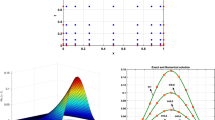Abstract
Weighted essentially non-oscillatory (WENO) finite difference schemes, developed by Liu et al. (Comput Phys 115(1):200–212, 1994) and improved by Jiang and Shu (Comput Phys 126(1):202–228, 1996), are one of the most popular methods to approximate the solutions of hyperbolic equations. But these schemes fail to provide maximal order accuracy near smooth extrema, where the first derivative of the solution becomes zero. Some authors have addressed this problem with different weight designs. In this paper we focus on the weights proposed by Yamaleev and Carpenter (J Comput Phys 228:4248–4272, 2009). They propose new weights to provide faster weight convergence than those presented in Borges et al. (J Comput Phys 227:3191–3211, 2008) and deduce some constraints on the weights parameters to guarantee that the WENO scheme has maximal order for sufficiently smooth solutions with an arbitrary number of vanishing derivatives. We analyze the scheme with the weights proposed in Yamaleev and Carpenter (J Comput Phys 228:4248–4272, 2009) and prove that near discontinuities it achieves worse orders than classical WENO schemes. In order to solve these accuracy problems, we define new weights, based on those proposed in Yamaleev and Carpenter (J Comput Phys 228:4248–4272, 2009), and get some constraints on the weights parameters to guarantee maximal order accuracy for the resulting schemes.








Similar content being viewed by others
References
Aràndiga, F., Baeza, A., Belda, A.M., Mulet, P.: Analysis of WENO schemes for full and global accuracy. SIAM J. Num. Anal. 42(2), 893–915 (2011)
Borges, R., Carmona, M., Costa, B., Don, W.: An improved weighted essentially non-oscillatory scheme for hyperbolic conservation laws. J. Comput. Phys. 227, 3191–3211 (2008)
Casper, J., Carpenter, M.H.: Computational considerations for the simulation of shock-induced sound. SIAM J. Sci. Comput. 19(3), 813–828 (1998). (electronic)
Donat, R., Marquina, A.: Capturing shock reflections: an improved flux formula. J. Comput. Phys. 125(1), 42–58 (1996)
Engquist, B., Sjögreen, B.: The convergence rate of finite difference schemes in the presence of shocks. SIAM J. Numer. Anal. 35(6), 2464–2485 (1998)
Harten, A., Engquist, B., Osher, S., Chakravarthy, S.: Uniformly high-order accurate essentially nonoscillatory schemes. III. J. Comput. Phys. 71(2), 231–303 (1987)
Henrick, A., Aslam, T., Powers, J.: Mapped weighted essentially non-oscillatory schemes: achieving optimal order near critical points. J. Comput. Phys. 207, 542–567 (2005)
Jiang, G.S., Shu, C.W.: Efficient implementation of weighted ENO schemes. J. Comput. Phys. 126(1), 202–228 (1996)
Liu, X.D., Osher, S., Chan, T.: Weighted essentially non-oscillatory schemes. J. Comput. Phys. 115(1), 200–212 (1994)
Mulet, P.: The maximal order of semidiscrete schemes for quasilinear first order partial differential equations (2012). Submitted
Shu, C.W., Osher, S.: Efficient implementation of essentially non-oscillatory shock-capturing schemes. J. Comput. Phys. 77(2), 439–471 (1988)
Shu, C.W., Osher, S.: Efficient implementation of essentially non-oscillatory shock-capturing schemes. II. J. Comput. Phys. 83(1), 32–78 (1989)
Sod, G.: A survey of several finite difference methods for systems of nonlinear hyperbolic conservation laws. J. Comput. Phys. 27(1), 1–31 (1978)
Woodward, P., Colella, P.: The numerical simulation of two-dimensional fluid flow with strong shocks. J. Comput. Phys. 54(1), 115–173 (1984)
Yamaleev, N., Carpenter, M.: A systematic methodology for constructing high-order energy stable WENO schemes. J. Comput. Phys. 228, 4248–4272 (2009)
Yamaleev, N., Carpenter, M.: Third-order energy stable WENO scheme. J. Comput. Phys. 228, 3025–3047 (2009)
Author information
Authors and Affiliations
Corresponding author
Additional information
This research was partially supported by Spanish MINECO Grant MTM 2011–22741.
Rights and permissions
About this article
Cite this article
Aràndiga, F., Martí, M.C. & Mulet, P. Weights Design For Maximal Order WENO Schemes. J Sci Comput 60, 641–659 (2014). https://doi.org/10.1007/s10915-013-9810-0
Received:
Revised:
Accepted:
Published:
Issue Date:
DOI: https://doi.org/10.1007/s10915-013-9810-0




